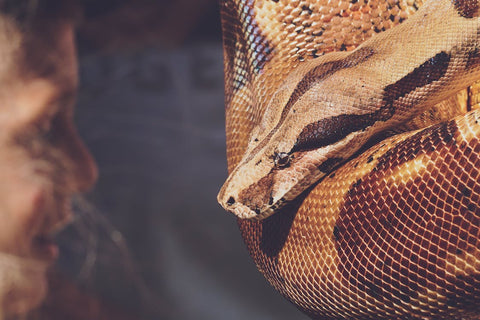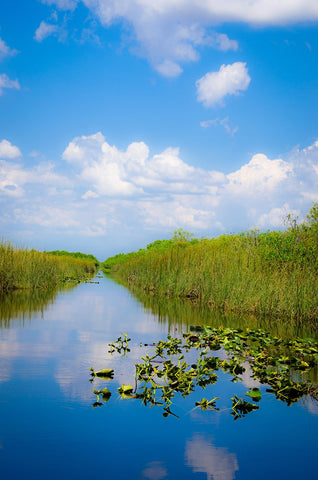Invasive Species Profile: Burmese Python
- Blog
- 29 Feb, 2024
In the lush and intricate ecosystem of the Florida Everglades, an unexpected predator has established its domain, altering the delicate balance of nature: the Burmese python (Python bivittatus). Once confined to its native habitats in Southeast Asia, these massive constrictors have found a new home in the subtropical wilderness of southern Florida. While their introduction may have seemed innocuous, the repercussions have been profound, heralding a cascade of ecological consequences.

Origins of the Invaders
The story of Burmese pythons in the Everglades begins with exotic pet trade. Initially brought to the United States as pets, many of these pythons found themselves released into the wild by owners who could no longer care for them or by accidental escapes. With Florida's warm climate and ample prey, these adaptable snakes found the perfect environment to thrive and multiply.
A Silent Invasion
The Everglades, with its dense mangroves, sawgrass marshes, and labyrinthine waterways, provided an ideal refuge for Burmese pythons to establish themselves. With few natural predators and an abundance of prey ranging from small mammals to wading birds, these apex predators quickly expanded their territory.
Ecological Impact
The introduction of Burmese pythons has triggered a domino effect within the Everglades ecosystem. Their voracious appetite has led to a decline in native wildlife populations, including raccoons, rabbits, and even the endangered Key Largo woodrat. The disappearance of these species has disrupted the food web, affecting other wildlife populations and altering vegetation dynamics.
Challenges in Control
Efforts to control the Burmese python population have proven challenging. Their cryptic nature and ability to blend seamlessly into their surroundings make them difficult to detect. Furthermore, their prolific breeding rates and vast, inaccessible habitat make eradication efforts a daunting task.
Physical Characteristics
Burmese pythons are renowned for their imposing size, with adults reaching lengths of up to 20 feet or more and weighing several hundred pounds. Their sleek bodies are covered in smooth, iridescent scales that range in color from tan or brown to dark olive green, adorned with irregular blotches or patterns that help camouflage them in their surroundings. These powerful constrictors have muscular bodies and distinctive heads with heat-sensitive pits, which aid in locating prey.

Habitat and Range
Native to the tropical forests and grasslands of Southeast Asia, Burmese pythons are highly adaptable and can thrive in a variety of habitats, including rainforests, swamps, marshes, and even agricultural areas. They are excellent swimmers and are often found near water, where they can hunt for prey and seek refuge. In their native range, they inhabit countries such as Myanmar, Thailand, Vietnam, and Indonesia.
Feeding Ecology
As ambush predators, Burmese pythons primarily feed on a diet of mammals, birds, and occasionally reptiles. Using their keen sense of smell and heat-sensing pits, they detect the presence of prey and lie in wait, striking with lightning speed when an opportunity arises. Once captured, they employ powerful constriction to subdue their prey before swallowing it whole. Their ability to consume large meals enables them to go for extended periods without feeding.
Reproduction and Life Cycle
Burmese pythons are oviparous, meaning they lay eggs to reproduce. During the breeding season, which typically occurs in the spring, males engage in combat rituals to compete for mating opportunities with females. After mating, females seek out suitable nesting sites, such as hollow logs or burrows, where they lay clutches of eggs, which they then coil around to provide warmth and protection. After an incubation period of about two to three months, the hatchlings emerge, ready to fend for themselves.
Collaborative Solutions
Addressing the Burmese python invasion requires a multifaceted approach. Collaboration between government agencies, conservation organizations, researchers, and the public is crucial. Initiatives such as removal programs, monitoring efforts, and public awareness campaigns aim to mitigate the impact of these invasive predators and restore ecological balance to the Everglades.

Looking Ahead
As we grapple with the presence of Burmese pythons in the Everglades, it serves as a stark reminder of the far-reaching consequences of human actions on natural ecosystems. While the challenges posed by these invaders are significant, they also present an opportunity for innovation, collaboration, and conservation efforts to protect and restore one of the world's most unique and fragile ecosystems.
In the heart of the Everglades, the battle between native wildlife and invasive predators rages on, shaping the future of this iconic landscape. Only through concerted effort and unwavering dedication can we hope to stem the tide of this silent invasion and preserve the rich biodiversity that defines this natural treasure.
Foundry Outdoors is your trusted home for buying archery, camping, fishing, hunting, shooting sports, and outdoor gear online.
We offer cheap ammo and bulk ammo deals on the most popular ammo calibers. We have a variety of deals on Rifle Ammo, Handgun Ammo, Shotgun Ammo & Rimfire Ammo, as well as ammo for target practice, plinking, hunting, or shooting competitions. Our website lists special deals on 9mm Ammo, 10mm Ammo, 45-70 Ammo, 6.5 Creedmoor ammo, 300 Blackout Ammo, 10mm Ammo, 5.56 Ammo, Underwood Ammo, Buffalo Bore Ammo and more special deals on bulk ammo.
We offer a 100% Authenticity Guarantee on all products sold on our website. Please email us if you have questions about any of our product listings.



